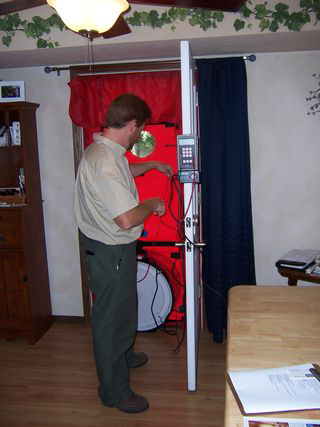
by blogediter | Sep 14, 2018 | Chimney Problems
Energy audit
Q: Jason, I have a wood burning fireplace with a cozy great heater insert. I have a top of the Chimney Balloon and traditional damper installed. I have bad downdrafts and soot smell on rainy, windy days.
I am a Home Inspector and I am in the middle of a Certified Energy Training Program with RESNET. I just received a copy of Energy Magazine and read about your product. Looks like a good idea. I am going to try the vinegar tip. I need to measure my flue and I will order to try on my house. Once I get my blower door I will try the test like you did. I have doors, 2 dampers, and the Chimney Balloon. Thanks.- MW
PS. I will tell all my clients if I have success with your product. Nice website by the way and I am posting it on a few inspection association boards for others to try.
A: Hi MW, That was a great article you were referring to in Home Energy magazine (Mar/Apr 09) the energy rater that did the testing of the Chimney Balloon (Mark Furst) for that article did a great summarizing his testing of the Chimney Balloon. Mark was chosen to do the review/test because he had no experience with the Chimney Balloon, and could give an unbiased opinion. Mark also has a great reputation in Wisconsin for being very thorough at energy rating. We cannot re-post the article for copyright reasons, but you can click here to see a PDF of a summary of the Chimney Balloon article.
We would really welcome your comments and test results if you decide to do your own blower door testing of the Chimney Balloon with your fireplace.
We have not had the opportunity yet to compare the Chimney Balloon to the top seal dampers in blower door testing. I know the top seal dampers tend to seal tighter than traditional low-in-the-firebox metal dampers, but the trouble that is often experienced with a top seal damper is you are sealing the Chimney Balloon and all of its creosote and soot content into the homes interior air envelope by bottling the chimney at the top. What further compounds the issue is the fact that the warm interior air that naturally ascends the Chimney Balloon and is trapped there by the top damper tends to cool against the uninsulated brick walls of the chimney and the cold metal of the top damper and then that now-cool air drops again to the firebox. This convection process and air movement creates a draft and odor sensation at the hearth and into the room. That could be what you are experiencing.
The Chimney Balloon installed low and close to the firebox seals of the chimney from the homes interior air and eliminates this convection and air movement. – Jason
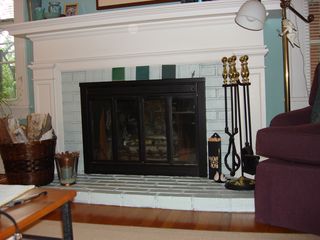
by blogediter | Sep 12, 2018 | Fireplaces
FirePlace
Dear Jason,
We have used the Chimney Balloon for over a year now and it is like a weight lifted off our shoulders. We have tried many things to get rid of the smokey smell from our fireplace. We had even duct taped plastic sheeting over it. That worked for awhile until the duct tape lost its hold eventually and we were constantly pressing it down again to get a tight seal.
We had the chimney cleaned and a locking top [damper] installed. Even after spending several hundred dollars we were left with the same smoky smell. It was really bad on hot humid days!
Your [Chimney Balloon] product has been the perfect solution and now we have one less thing to worry about. Thank you so much!
Anna Marie B.
Lake Forest, IL
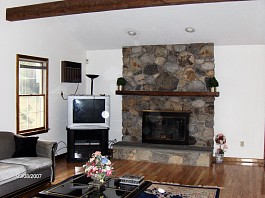
by blogediter | Sep 10, 2018 | Chimney Problems
My fireplace
Q: Jason, I have a problem when I use my fireplace-Initially, smoke was occasionally coming in and I would feel very sick from the fumes- headaches, dizzy, nauseous.
We had an expert come out and inspect it- he capped off an older part of the chimney that he thought could be causing smoke and fumes to be pulled into the house. (We have a fireplace indoors- that attaches to a grill on the outside of the house- he capped off the grills chimney top).
Now, we have started using the fireplace again- and I am still getting bad headaches. Not right away- but after an hour or two, I get a pretty bad headache. There is no visible smoke coming in- but I feel like something is still wrong.
We purchased a carbon monoxide detector, and it isn’t warning us of any trouble.
Now, the meat of the question: Our central heating intake is on the ceiling about 15 feet away in a direct path from the fireplace. I am wondering if when the heating comes on, the intake is pulling fumes into the house and making me sick.
I’m sorry for the long question- I just wanted to be as thorough as possible. We have consulted the only expert in town and he can find no problems. Many thanks for the informative website. – AP
A: Hi AP, The trick about fireplace use is it turns your home into a huge vacuum. The fireplace is sucking the air out of the home in great volume for combustion and to exhaust heat up the chimney. This makes the home intake air through routes that it might not otherwise intake through under normal situations.
It could be that your fireplace is causing such a suction it may be back-drafting your furnace flue, water heater flue, or even through an attached garage door. It is good that you have a carbon monoxide detector in the home.
Or you could have developed a sensitivity to the carcinogens in burning wood or the fireplace may be putting our NO2 or another aggravating or dangerous gas. This sensitivity is very common. Some people have bought Chimney Balloons just to seal off the chimney from their homes interior air. The passive exposure of their inside air to the creosote, soot and other contaminants in the chimney residue bother them even without the fire.
I do have one other questions for you though…what type of wood do you generally burn and how long have you tried it for? – Jason
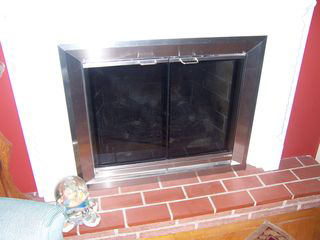
by blogediter | Sep 7, 2018 | Gas Logs
Q: Jason, I bought my Virginia home about 3 yrs ago, and have never thought about the amount of heat / ac leaving the home until seeing a “home energy saving” piece on the local news. They recommended using a “Chimney Pillow” as a possible solution.
So, I came to your website, spent the last 90 minutes reading EVERY one of your replies to all of these posts, and have become not only more educated on this topic but have developed an admiration for your knowledge & straightforwardness.
The extent of my expertise with fireplaces ceases after the determination has been made that I actually have gas logs (which I do) & not real wood!
Question: How would I know if I have Vented Gas Logs or Non-Vented Gas Logs?
There is a damper (presumably installed during the 1988 construction), which has been closed since move-in day. There is also a gas line that has been turned off since move-in day. I have a VERY cold fireplace & a relatively new chimney cap (installed as a condition of sale 3 yrs ago).
I am fairly convinced that I need a Chimney Balloon, but at 300 lbs with no official contortionist training, I have been reluctant to take the time to remove our toddler gate which would be required to gain access to the fireplace allowing for an appropriate measurement (trust me, it is an event to take this thing apart…14 ft of it that encircles the entire family room)!!
So I guess the first step is determining the vented vs. non-vented issue, then get to work on the toddler gate. Thank you in advance for your time & consideration! – MW
A: Hi MW, I’m sorry it took so long to respond to your post. It has been a very busy week on the phones.
To see if you have a vented or non-vented gas log I would look first on the manufacturer plate on the gas log burner itself. It is usually by the knob that controls the flame height. It should be indicated there. If you can even find a model # you can google that number and see what comes up. If there is no indicator of manufacturer or model on the burner unit, about all you can do is call a professional to come and look at it or take some digital photos of it to a fireplace retailer and get their input.
There is no simple way to identify a vented gas log from a non-vent if it is not marked, even professionals have a hard time indentifying one from another. I have seen plenty of homeowners assume they had a no-vent just because the damper was not removed or clipped open, but it turned out they had a vented unit. Getting this mixup wrong can be lethal, so it is nothing to guess at.
Since you gas log is disabled/inoperable and the gas is shut down to it, you can install a Chimney Balloon to stop the cold draft. Just make sure you mark the gas valve clearly with the red lockout tag that comes with a Chimney Balloon.
If you are not comfortable getting your fireplace fitted and installed for a Chimney Balloon I would look in the phone book for an energy rater to do a house call to measure and install one. Most energy raters and insulation contractors and some chimney sweeps are familiar with Chimney Balloons and can install one for just the cost of a 1 hr house call.
Or if you feel adventurous and you have a folding carpenters ruler in-hand you can call us in tech support (608-467-0229) and we can walk you through the measurement process. It is not really that hard if you have a folding carpenters ruler. It is much easier than using a tape measure. – Jason
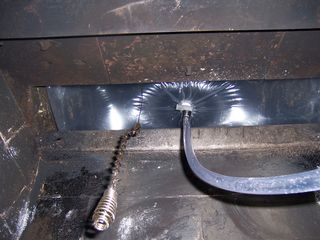
by blogediter | Sep 5, 2018 | Chimney Problems
Cable Coming Down the Flue
Q: Jason, I have a 113-year-old house with 6 fireplaces … they were originally coal-burning units .. they all have the damper on the top of the chimney … will the Chimney Ballon work with that configuration? -GB
A: Dear GB, WOW 6 fireplaces! that has to be some kind of record! It is very wise that you have a chimney top damper on these chimneys, however, the chimney top damper still allows the warm air of your home to rise up into the chimney and cool in the chimney and sink back down. You may notice a slow cool release of air from your fireplaces. That cool air is likely not outside air but just cooled inside air sinking back down again.
I have had customers with chimney top dampers that have used the Chimney Balloon on the bottom of their chimney in addition to their top damper and it has made a difference. With 6 chimneys the difference would be significant.
Q: Jason, thanks for the response … one of my concerns is if the damper cable will interfere with the Chimney Balloon sealing properly.
A: Recently a homeowner in Detroit asked me the same question you are asking when he ordered 3 Chimney Balloons for his home. He had Lock-top dampers just like you, on all three chimneys as well. After he installed the Chimney Balloon he reported that it sealed just fine despite the cable & chain. The balloon simply presses the chain against the flue wall or expands around it causing no leak or draft. You can install the Chimney Balloon with the cable tight or relaxed. The image above is a picture of the Chimney Balloon installed with the damper cable relaxed. But here is an article with a picture of a Chimney Balloon with the cable tight: http://www.chimneyballoonusa.com/blog/2007/11/my-lock-top-or-.html
– Jason




